Charger Hellcat Offers 707-HP Family Sedan
Filed under: Weekly test drives, Autos
By John Gilbert
Maybe you’ve heard about the techniques of professional drag-racing, where drivers line up at the amber starting lights, then time it as perfectly as they can to launch without “red-lighting” an instant before the green light shows.
If you can find a place to try that in the ol’ family truckster, it’s fun. And if you happen to be driving a 2015 Dodge Charger SRT Hellcat, it’s more than just fun. Sure, it costs a little more than the garden variety Charger — close to $65,000 — but it comes fitted with a 707-horsepower supercharged 6.2-liter Hemi, and various accompanying toys.
One of them is that on the instrument panel, along with showing you your speed and RPMs and fuel gauge, you can switch to several screens. One of them, under “performance,” gives you a cluster of numbers between the speedometer and tach. Set it for 0-60, or 0-100, or a quarter-mile, and then hit the button when you’re ready to go. It counts down, and when it gets to your starting time, you accelerate as hard as you dare. The readout not only gives you a timed clocking of how you did, but it also shows your starting-line reaction time, for how close you cut the launch to the quickest possible time.
I found a deserted stretch of rural highway, and set the device for 0-60. Then I hammered it. After a couple runs, I showed a best time of 4.4 seconds. Dodge says the car will do the quarter mile in less than 14 seconds, and I have no reason to question that. If you know of a deserted stretch of rural highway, you realize immediately that you could spend a few bucks refueling before you get over the adrenaline kick of spending an afternoon playing with that Charger Hellcat.
The best thing about it, along with the looks and the amazing performance, is that when you simply start the engine and crack the throttle, people stop and stare, while you’re just happy your windows didn’t shatter. Read more
MX-5 Miata Becomes Bargain Exotic for 2016
Filed under: Equinox, Weekly test drives, Autos
By John Gilbert
Hurry! If you live in the warmer part of the country, there’s no urgency; but farther north, where the ominous approach of cold weather and a little snow and ice is nearing, sports car driving can become a seasonal venture, and the leaf-changing time of autumn might be the best time possible.
If you own a Porsche Cayman, or a Jaguar F-Type, an Audi TT, BMW Z4 or an Alfa 4C, there’s no real urgency, because you undoubtedly can afford to pick your spots. But if you want the same thrill, possibly amplified by the knowledge that you beat the system by spending about one-fourth of the required investment of the above-named roadsters, then run — don’t walk — to your closest Mazda dealer and pick off a 2016 MX-5 Miata for half the sticker price or less.
The base Miata Sport starts at $24,915, and moving up to the Club is $28,600, with the top Grand Touring starting at $30,065. The Club is what I drove, and it adds a limited slip and Bilstein shock absorbers and an inch larger wheels if you pick the Sport package.
Jump into the Miata, flip the closure lever and lower the top with one hand — no power gizmos, please. Start up the Skyactiv engine, shift into gear and take off. The feeling of exhilaration is instant and always the same. Fantastic. If it feels even more compact than you anticipated, it is. Its 154.4-inch length is more than an inch shorter than the original was in 1990, although wheelbase as 1.7 inches stretched on the new car, and width is a couple inches more.
With Mazda, the power and torque numbers mean very little. If it feels fast enough to give you a thrill, it is. The new Skyactiv 2.0 has 155 horses and 148 foot-pounds, and the outgoing 2.0, without Skyactiv technology, actually had more horsepower at 167 at 7,000 revs, with less torque at 140. I never know how Mazda does it, but the new car feels quicker in a more coordinated way where the engine, gearbox, electric power steering and suspension all contribute.
For 2016, even the crustiest traditionalist among Miata fans will have to admit that as good as the first three generations of the Miata have been, the fourth-generation version gives you the largest jump forward in technology, and also provides some visual exhilaration, from the first time you lay eyes on it. Read more
If You Want a Hybrid, Would a BMW i8 Do?
Filed under: Weekly test drives, Autos
By John Gilbert
Since my first turn in a 1968 2800 CS Coupe, I’ve driven virtually everything BMW has produced, which includes the 1600 and 2002, continues on through the 3-Series, 5-Series, 7-Series, the newest 1, 2 and 6 models, assorted X-model SUVs, and a couple more I’ve overlooked.
A couple of certainties follow: 1. All of them were and are impressive from an engineering and utilitarian standpoint, and 2. None of them could possibly prepare you for a drive in the i8.
The 2015 BMW i8 is the ultimate dream car. A reason-bending concept car brought to life, fulfilling fantasies and adding futuristic ideals that reach beyond those fantasies. We all have been reading about the latest global-warming, climate-changing, high-risk trends of today’s world, and the most logical conclusion is that our driving machines are going to become electrified in some manner. So why not make a lifestyle statement and make your next car a hybrid?
Also, if you live in a Northern climate, rich with snow in the winter, all-wheel drive is a nice feature. Let’s further imagine that you could buy any car on the planet — although that might be a bit harder to grasp. The i8 price tag is $136,650. If you hear the price while gazing at the car, it doesn’t seem as shocking. Especially if you have any idea of the price sticker for a Ferrari, Porsche, Maserati, Jaguar, McLaren, or Aston Martin.
As far as other subjective characteristics you and your co-driving wife might embrace, you’d obviously prefer something visually striking, maybe a great looking sporty car with the added emotional investment of performance that’s up there with the elite top exotics. The BMW i8 can meet and exceed all those fanciful ideas.
It is built of carbon-fiber, that magical material that is, they say, three times lighter and several times stronger than steel. The car weighs in at 3,378 pounds, all of which are distributed front to rear at a nearly ideal 49/51 ratio.
I hadn’t bothered to investigate the i8’s details fully since it started making the auto-show round, because I suspected it might just be a design exercise. When one appeared in my driveway in Duluth, Minnesota, however, it was time to either learn about it or find a respirator. I knew BMW had come out with an electric i3 subcompact sedan, but I still couldn’t believe the i8 had been brought to life.
For visual impact, there may be nothing else that approaches the stunning looks of the i8. If there is, it would have to be a $300,000-range super-car named Ferrari, Lamborghini, or McLaren.
The i8 is a glistening metallic silver, with a black roof panel, and black lower sides tastefully set apart by an electric-blue borderline that varies in width. That lower black wraps around the lower front end, and rises up to fully set off the rear end’s dramatic curves and layers. The i8 is so low that you feel that with a couple of hard strides you could quite easily hurdle it.
At the time, and maybe still, there had never been another i8 in Duluth, or anywhere else in Northern Minnesota — even passing through. It’s important to look cool when you’re approaching a car like this, but any semblance of patience disappeared when I popped the driver’s door, which swings upward, hinged in front, and displays the low bucket seats. You might at first overlook the fact that there are two jump seats behind those buckets, and overlooking them is probably a good idea, because a human would have to be tiny to even attempt to squeeze back there.
Never mind all that. You’re in the driver’s seat, and you have fired up the ignition and moved the shift lever into its drive slot. That takes a bit of ingenuity, just getting it out of park and past reverse. The indicator says I’ve successfully engaged first, so we’re off. The car shoots forward, instantly gaining your full respect with its super-car-like acceleration. Sounds good, too, although you ain’t heard nothing, yet.
Handling is incredible. The car is so low, with such a low center of gravity, that you feel you might become part of any road irregularities. You are encased in the bucket seat with excellent support, and snaking around turns on the curviest smooth roadway you can find is a joy to experience in the i8. Imagining it on a road-racing track is automatic, but so is straight-line acceleration.
Less attractive is planning to extricate yourself from the cockpit. Getting in is no problem, because you learn ways to go in backwards or sideways and pull in your legs later. Getting out, though, requires some gymnastic agility. I developed a partial-Western-roll, much like high-jumping form. Start to roll on your side, fling a leg out, and do a little hop-step, hoping that you land on your feet.
Driving through town is an interesting experience, because unless you’re a complete show-off, you try to avoid glancing in either direction, where everybody on either sidewalk has stopped, frozen in their tracks, to stare wide-eyed and slack-jawed at this apparition.
The only folks who might take action are those in other vehicles — even sensational other vehicles — making u-turns and following you to wherever you’re going. Pull off onto an exit ramp and the mirrors indicate you’re the lead car of a parade. You stop, and you are immediately surrounded by a herd of folks who just want to know about the car.
The i8 will shoot 0-60 in 4 seconds; maybe a couple ticks less. I have no idea what the top speed might be, although someday I’d like to find out, if a road-racing track or an autobahn becomes accessible.
It has 362 horsepower and 412 foot-pounds of torque, and we haven’t even gotten to the surprises yet.
First surprise: The engine is a 3-cylinder, measuring 1.5 liters. Huh? BMW is one of the world’s leading proponents of making engines smaller and more potent, and it makes modular sense to build engines that measure a half-liter per cylinder. A 6-cylinder measures 3.0 liters, and the 4-cylinder measures 2.0. Taking off one more cylinder leaves you with 1.5 liters.
Surprise No. 2: The tiny engine is turbocharged, making those 4-valves-per-cylinder pistons churn up and down in well-choreographed harmony.
Surprise No. 3: The i8 is a hybrid. Two electric AC-induction motors operate off a 7.1 kilowatt-hour, lithium-ion battery pack.
Surprise No. 4: The i8 has all-wheel drive. That helps it handle so dramatically well, but required precise calibration back in the factory laboratory.
Surprise No. 5: The coordination approaches miraculous. The gas engine develops 228 horsepower and the electric motors add 129 horsepower for a combined 362. The gas engine alone develops 236 foot-pounds of torque, while the electric motors add 184 more, reaching that 420 figure. The turbo gas engine powers the two rear wheels through a 6-speed automatic transmission; the two electric motors push the two front wheels via a 2-speed transmission. Coordinating it all is seamless and smooth to the driver.
As with any hybrid, a careful driver can coax a certain distance on silent electric power alone, but it takes patience. Ideally, you’d want to plug your i8 in for an hour on a 240-volt, 80-amp charger, or a bit longer on normal household 110, to get it fully charged. if you drive away and step lightly on the gas pedal, you can go silently and effortlessly for about 25 miles on pure electric. Stepping on the gas hard, or trying to accelerate quickly, brings the gas engine on to join the electric, which might be more satisfying, but cuts into your green-ness.
Gauges tell you when you’ve about exhausted the electricity, after which you’ll go on gas-engine only.
Then there’s Surprise No. 6: Pull the shift lever over to the left, into “Sport,” and you immediately get a surge both in power and in exhilaration, because the sound — helped by amplification through the speakers — is almost other-worldly with its snarling roar. It is in that Sport mode that the engine uses the gas engine’s power to help regenerate the battery pack. Recharging never sounded so sweet.
You won’t ever reach full charge with just the gas-engine input, so plugging in the i8 makes the best sense. Still, all-electric cars run impressively for a limited distance, then need to stop for several hours of recharging, no matter what time the game starts. You can keep driving on gas in the i8, and driving also juices up the battery pack enough to enjoy more full-electric driving, though for briefer stretches. Just like a “normal” hybrid.
If you owned an i8, you would develop some tricks to keep it charged and increase your effective fuel economy up to lofty heights, like maybe 75 or so miles per gallon.
Just remember that ace in the hole, for justifying such a large chunk of the family budget. Come home and announce that you’ve made the decision to help the world and your winter challenges by getting a car that is both a hybrid and an all-wheel-drive vehicle. Then let her get a glimpse of the i8 parked outside. Chances are she’ll be so blown away she won’t even ask you how much it cost.
New Murano Lures Old, and New, Buyers
Filed under: Equinox, Weekly test drives, Autos
By John Gilbert
It is impossible to not be impressed with all that Nissan has been doing in the past few years, and the new 2015 Murano luxury SUV is one of the more recent examples.
Strong engines, more engaging designs, much improved handling and sportiness, and constantly increasing sales from its lowest priced economy cars up through its costliest SUVs and its superlative Infiniti upscale line have conspired to lead Nissan to expanding popularity.
But I have a confession. As a long-time auto journalist, I have disciplined myself to be completely objective about the ingredients that go into each car, and I am thoroughly impressed with the latest technology, whatever company offers it. But I retain the right to have my likes and dislikes. Could I buy a car that has mediocre technology if I really liked the styling? Probably. Could I buy a car that has fantastic technology if I disliked the appearance? Probably not.
My confession is that I never liked the Murano. There. I’ve said it.
When it comes to Nissan SUVs, I have always felt like the Pathfinder midsize SUV might have been custom-built to fit me. The huge Armada is impressive, and angular, although it’s too large to appeal to me.
The compact Rogue, meanwhile, is a favorite of mine, and my wife Joan’s. It works in all weather, it’s big enough for us — and most SUV and crossover customers — and everything works, particularly when it’s time to go from front-wheel to all-wheel drive, and you can lock it in 4×4. It will roll happily in good weather and churn through the occasional 40-inch-plus snowfall we’ve come to know and love in Northern Minnesota.
Even the tiny, and decidedly weird, Juke has considerable appeal, because you can get it with all-wheel drive and it performs like it rather enjoys its identity crisis that makes it both a sports car and an SUV. I particularly liked the active-lifestyle Xterra, although it didn’t sell well enough to survive.
Amid that flurry of SUVs, the Murano showed up and attracted some friends of mine amid its customers. They loved it’s luxury and its features. I liked everything about it, except its styling. It looked to me as though Nissan might have taken the rugged, off-road-aimed Pathfinder and left the clay model of it too close to the fireplace, causing it to melt until it drooped down inelegantly at the front and rear. I like aerodynamics when they cheat the wind, but less when they are just droopy.
Some of those sloped-nose and rounded rear lines found themselves onto much costlier Infiniti models, and I wasn’t enamored with them, either. I know, also, that I might be unfair in my assessment, and I never let it intrude on my analysis of the mechanical wonders and creature-comforts of those vehicles so-afflicted. The reason this is the right time to come clean is this all-new Murano for 2015.
It has been thoroughly redesigned as third generation, and it looks nothing like the outgoing Murano. I like the looks of the new Murano, and I like the way it drives, with good power and impressive handling, and a firm, road-holding capability that puts it on the upper strata of moderately priced SUVs. We first drove the Murano up the Pacific Coast in California, stopping to appreciate the crashing surf and the occasional sea lions.
From the side, the new Murano is all contours and pleasing bulges, first lifting over the large front wheelwell, then meeting up with a line coming off the top of the fender, from which that contour rises gracefully back to the taillight. Meanwhile, a chrome strip underlining the side windows, kicks up into an interesting but style-only bulge that comes back down to also meet at the taillight.
From the front, the Murano looks all new, much more like a sibling of the Pathfinder and Rogue. The interior is stylishly luxurious, with a 7-inch color readout panel between the speedometer and tachometer, and a larger (8-inch) touchscreen at the top of the center stack. I have always admired Nissan’s navigation, particularly the maps, which can be adjusted to a 3D “birds-eye” view of the road ahead. However, I have grown to dislike touch-screens, only partly because one of my favorite stay-alert tricks on longer trips is a large sack full of popcorn, with butter and salt, please.
Eating popcorn slowly, one kernel at a time even, provides a steady crunch that is a welcome aid to alertness, but a little butter residue on the fingertips is not the proper recipe for operating a touch-screen. Even without the butter, it doesn’t take many fingertip-taps to pretty much cover the touch-screen with funny little fingertip marks — annoying enough to make you happy that Nissan also provides a couple of push-buttons to operate audio controls.
Other neat changes are in aerodynamics, where the coefficient of drag has been reduced impressively, and in creature features such as a large moonroof, and zero-gravity seats, which decrease stress and fatigue. The heated and cooled front seats and heated rears have more support for the lower femur and hips. Enlarged rear storage capacity offers expanded area behind the second row of seats.
A remarkable feature of the new Murano is the quietness inside, thanks to wider acoustic laminated glass in the windshield and hood insulation.
Use of high-grade steel helps lower the weight by 146 pounds on the Murano, which stays on the same platform, and maintains the 111.2-inch wheelbase, while lengthening by 3 inches to 192.8. Width is also increased by 1.3 inches.
While nobody quarrels with Nissan’s ability to build engines, there is an interesting philosophical thing going on with Japanese automakers. Apparently inspired by higher-powered and more-efficient engines from South Korea’s Hyundai, Mazda and then Honda redid their engines, modernizing them with direct injection and improving both power and fuel economy. Toyota and Nissan, on the other hand, have stayed with their engines, with port injection, which, good as they have been for over a decade, may leave them a jump behind in the technology game.
The 3.5-liter V6 in the Murano is familiar, refined to 260 horsepower and 240 foot-pounds of torque. The transmission verifies Nissan’s world-leading devotion to CVTs — continuously variable transmissions — which adjust engine speed by a variably enlarging set of pulleys rather than planetary gears. That can seem boring, because the engine tends to drone rather than rise to a peak, but it is efficient, and there is a manual-override capability that allows the driver to manually step up the cables to simulate a seven-speed automatic transmission.
Thicker stabilizer bars and improved steering make the new Murano corner and handle much better, and we swept around some twisty curves with smooth stability just to prove it. EPA fuel efficiency estimates are 21 city, 28 highway. Advanced safety items such as blind-sport detection, forward warning and emergency braking, and along with the full 360-degree monitoring system shown on the nav screen, many of the features can be ordered separately or by class.
The base Murano S starts pretty well equipped, and you can move up to SV, SL, or Platinum. The base vehicle starts at $29,995 with front-wheel drive, and works up to $40,000 for the Platinum with all-wheel drive and the Navigation package. Nissan foresees a 50-50 split between front-drive and all-wheel drive.
If you liked the looks and features of the current second-gen Murano, you’re sure to be impressed with this new third-generation model for 2015. And if you never did like the Murano, there’s a fighting chance you’ll still like the new one.
Refined, Restyled, Sonata Remains Midsize Icon
Filed under: Equinox, Weekly test drives, Autos
By John Gilbert
When Hyundai redesigned its midsize Sonata for the 2011 model year, a trusty and useful caterpillar was transformed into a stunning and award-winning butterfly, and the overall success of the Sonata gave the South Korean company an instant signature vehicle.
Boasting a sketchpadful of curvaceous contours, it also was blessed with new levels of high-grade steel — from its own steel plant — for lightness without compromising safety, and an all-new 2.4-liter 4-cylinder engine that bristled with sporty power, thanks to a futuristic high-pressure/low-temperature but costly direct injection system. Hyundai hooked it up to its own corporate 6-speed automatic transmission that was built in-house and was lighter and smaller than the less-efficient aftermarket 5-speed transmissions used by other companies.
All those features gave the Sonata a technical edge on its competition almost before suddenly the Accord, Camry, Mazda6, Fusion, Malibu and Altima knew that more than midsize room and sportiness were being challenged. Despite the edge in technology and fuel efficiency, the Sonata also came in several thousand dollars lower in sticker price. As if to prove that everything could be star-crossed into one vehicle, the 2011 Sonata was U.S. built, in a new plant in Montgomery, Ala., while its engine plant was 50 miles up the freeway.
I thought the Sonata was the most significant car introduced for 2011, and I mentioned to a Hyundai engineer back then that the car had all the ingredients to be the perfect contemporary vehicle. The only thing lacking, I suggested, was in steering and suspension, both for firmer handling, and also because they could be coordinated for the true sporty handling the car deserved. Those would be the toughest achievements, and take the longest to attain.
Still, self-teaching itself to create the ingredients was substantial enough that Hyundai could spread its new-found technical wealth around to its other vehicles. Within a couple of years, all its smaller 4s, larger V6es, and new V8s benefitted by direct injection and the in-house transmission.
A new entry-luxury Genesis was another part of Hyundai’s upsurge, which is a factor in the new-for-2015 scenario. A thoroughly renovated Genesis has just arrived for 2015, with smoothly flowing refinement and the proper room and features of a luxury sedan, with proper handling, having learned a few suspension tricks from consultation with Lotus engineers. It all works amazing well.
But before anyone could suggest the bargain-luxury Genesis had become Hyundai’s new signature model, the redesigned 2015 Sonata arrived. On the outside, the Sonata trades in the polarizing contours for a more formal look, which Hyundai calls “Fluidic Sculpture.” The new Sonata actually resembles the new Genesis more than it does the outgoing Sonata, leaving those curvy contours to remain distinctive for the 2011-14 Sonata, and replacing them with sweeping lines and a new, upright, Genesis-like grille.
“Instead of adding more flair, we put straighter lines on the sides, so it looks more like an athlete in a tight suit,” said Christopher Chapman, chief designer of the car.
The resemblance is striking if you park a Sonata alongside a Genesis. You could easily mistake one for the other, although the Genesis never looks like a bargain-priced midsize, even if the new Sonata takes on entry-luxury stature. Inside, the Sonata’s interior has been refined and restyled to appeal to every taste. But the real trick is underneath that exterior and interior.
Hyundai will never say that Lotus helped design the suspension of the new Genesis, but from vastly tightened and responsive steering and the far more coordinated suspension of both cars, we can theorize that Hyundai engineers applied some Lotus ideas to the rear-drive Genesis, then reconfigured it to revolutionize the front-wheel-drive Sonata’s feel.
In the corporate scheme of things, Kia gets joint-venture use of Hyundai engines and transmissions. Kia builds the Optima, a very slick parallel to the Sonata. The Optima has always had the benefit of more sporty touches, while the Sonata has been more, uh, pedestrian.
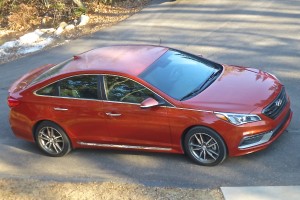 But the new Sonata, which starts with the same reliable and peppy 2.4-liter 4 standard, adds a couple of variants for 2015. A Sport version has the reduced-displacement 2.0-liter engine, which is turbocharged and direct-injected for a large boost in power, and the 6-speed automatic gets steering-wheel paddle controls for manual shifting. The steering wheel has a flat-bottom shape, similar to the Volkswagen Golf GTI, for those who might not push the Sonata Sport hard enough to appreciate its improved dynamics.
But the new Sonata, which starts with the same reliable and peppy 2.4-liter 4 standard, adds a couple of variants for 2015. A Sport version has the reduced-displacement 2.0-liter engine, which is turbocharged and direct-injected for a large boost in power, and the 6-speed automatic gets steering-wheel paddle controls for manual shifting. The steering wheel has a flat-bottom shape, similar to the Volkswagen Golf GTI, for those who might not push the Sonata Sport hard enough to appreciate its improved dynamics.
In addition, the Sonata is offered with Hyundai’s very peppy little 1.6-liter 4, lifted from the Accent, Elantra, and even the newly revised Tucson SUV in a hyper-economy model. Turbocharging makes it more than just an economy car. In a matter of weeks, Hyundai also will present a new hybrid Sonata.
After driving several models at the Sonata introduction, I spent a week with a glistening white Sonata Limited, and more recently was able to spend a week with a Sonata Sport. It was a unique off-red color, called “urban sunset,” and it came with the 2.0 turbocharged engine that produces 245 horsepower at 6,000 RPMs, and 260 foot-pounds of torque, which is not only a lot of punch, but peaks and remains constant all the way from 1,350 to 4,000 RPMs.
The car carved through curves and tight corners with precision, amplified by the paddle-shifting, which gives the Sonata part of its new personality. Greatly appreciated, too, is the coordination between the refined power steering and the new suspension — both tweaked to sport settings.
With stability management and traction control, the latest brake-force distribution and brake assist, plus all the high-tech features, such as blind-spot detection, rear cross-traffic alert, leather seats, automatically dimming rearview mirror, and Bluetooth and Blue Link connectivity, the Sonata Sport listed at $29,510. Definitely a bargain, considering the features and refinement contained within.
“More horizontal architectural lines create the reality of more control,” said Chapman, inadvertently describing the juncture of appearance with reality. “It’s built with safety, but it’s intuitive and comfortable while being safe. If we can turn safety into something sexy, the whole industry will be better off.”
Hard to quarrel with that. It’s all part of living up to its new image, although the explanation, impressive as it is, might still fall short of explaining how the previous generation Sonata had all the ingredients to be a great car, while the new one puts all those ingredients in place to reach that plateau of being a truly great car.


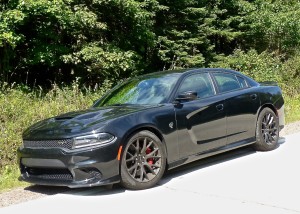
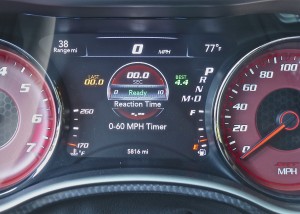

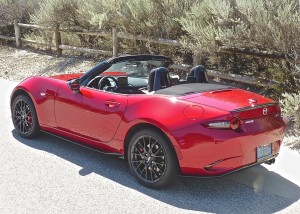
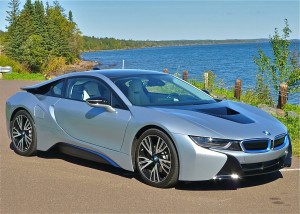
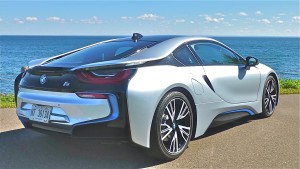
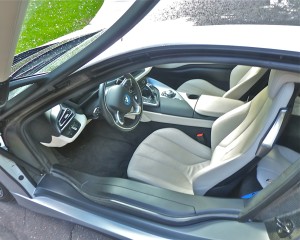


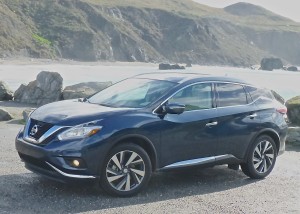
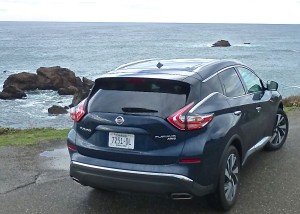


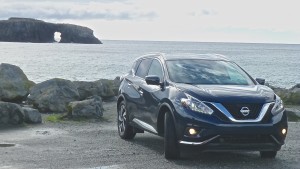
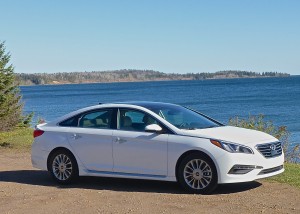
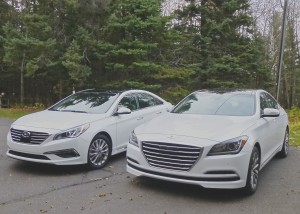
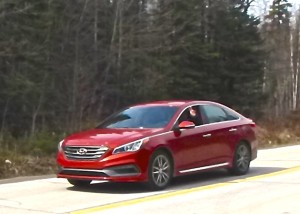
 John Gilbert is a lifetime Minnesotan and career journalist, specializing in cars and sports during and since spending 30 years at the Minneapolis Tribune, now the Star Tribune. More recently, he has continued translating the high-tech world of autos and sharing his passionate insights as a freelance writer/photographer/broadcaster. A member of the prestigious North American Car and Truck of the Year jury since 1993. John can be heard Monday-Friday from 9-11am on 610 KDAL(www.kdal610.com) on the "John Gilbert Show," and writes a column in the Duluth Reader.
John Gilbert is a lifetime Minnesotan and career journalist, specializing in cars and sports during and since spending 30 years at the Minneapolis Tribune, now the Star Tribune. More recently, he has continued translating the high-tech world of autos and sharing his passionate insights as a freelance writer/photographer/broadcaster. A member of the prestigious North American Car and Truck of the Year jury since 1993. John can be heard Monday-Friday from 9-11am on 610 KDAL(www.kdal610.com) on the "John Gilbert Show," and writes a column in the Duluth Reader.